Hello, it’s been a while since this blog has been online or updated. Good news: The server hosting the blog survived being in storage, and has again been cranked up and placed online!
Thank you to those who wrote notes of encouragement about the blog. They were definitely appreciated.
Even better news is that there are lots of things to write about. I thought I would start with two top Japanese pencils. A couple of years ago, these were very hard to acquire in North America. Thanks to the internet, they’re now possible (though still far from easy) to source.

The intriguing cap of the Tombow Mono 100
The Mitsubishi Hi-Uni is the top woodcase pencil in the Mitsubishi Pencil Company’s line. There seems to be no doubt that mechanical pencils are much more widely used in Japan, with woodcase pencils like these considered niche products.
This pencil’s packaging announces it – a light green cardboard sleeve with a cutout that lets one see a half dozen pencil crowns. Taking off the sleeve, there is a black plastic box with a clear plastic lid that pops up to allow access. The interior of the box has a many-spoked divider that keeps each of the twelve pencils separate. It’s heavier than any pencil box I’ve encountered, and definitely indicates that the contents are valuable.
The pencils are offered with a heavily varnished maroon finish, topped by a black crown. The stamping is gold, along with a white barcode. The pencils are also distinguished by the orange dot on their tops.
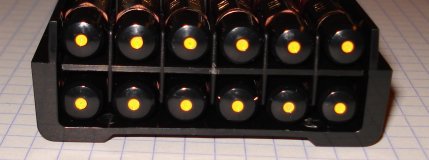
The intriguing cap of the Mitsubishi Hi-uni
They sharpen easily, and in HB have a very rich dark lead that doesn’t crumble. On paper, the markings seem reasonably smear proof. I look forward to trying some other hardnesses. I haven’t spent too much time with them yet, but hope to soon give them a lengthier workout. I’ve found that some pencils which do well for a few jottings aren’t necessarily great all day writers.
The Tombow Mono 100 is a legend, especially in the animation field. It has a reputation as a high quality professional pencil. Dick Blick calls it the “gold standard.” I’ve spent quite a few dollars not getting this pencil – ordering it and being sent something else. Anyhow, I’m glad to finally have a few in my stash. They’re black, with gold band, and a white stripe that traverses the pencil’s cap.
They’re just a wee bit longer than any non-erasered pencil I have. A slight compensation for their price, I suppose.
They sharpen well, and like the Hi-uni, have a dark rich lead. I have tried them for a sufficient period of time to confirm that they make a great writer.
To my eye, the finish of both pencils is disappointing. Maybe I was expecting too much, but they’re overcrowded with too many font faces – both of them. A pencil just doesn’t have room for six different fonts without being very distracting. And of course the almost ubiquitous bar code makes them less sleek. They do have superior paint finishes, though.
Now as pencils – they’re really good. They seem to have the dark lead (the right combination of graphite, clay, wax, and other ingredients) that’s so pleasing to see on paper, without the crumbling or quick point erosion that some other attempts at dark leads have seen.

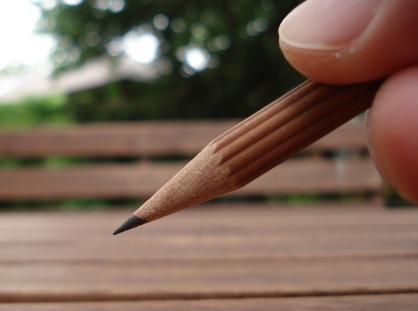
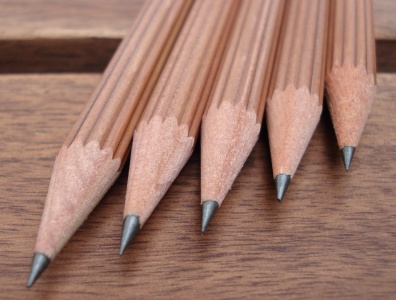
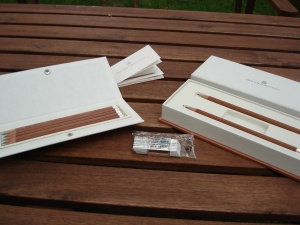
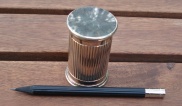

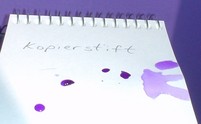
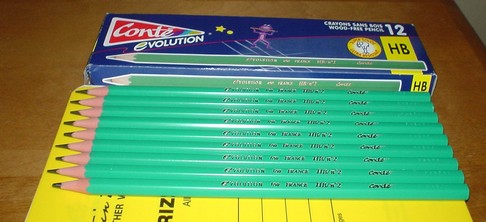

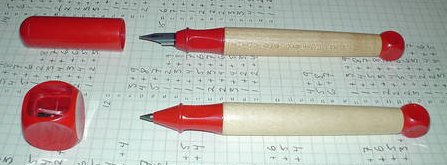
 The pencil is comfortable and writes very nicely. The lead is solid and doesn’t break. Though they ship with an HB lead by default, the pencils also take other hardnesses as well as colour leads from art supply stores.
The pencil is comfortable and writes very nicely. The lead is solid and doesn’t break. Though they ship with an HB lead by default, the pencils also take other hardnesses as well as colour leads from art supply stores.